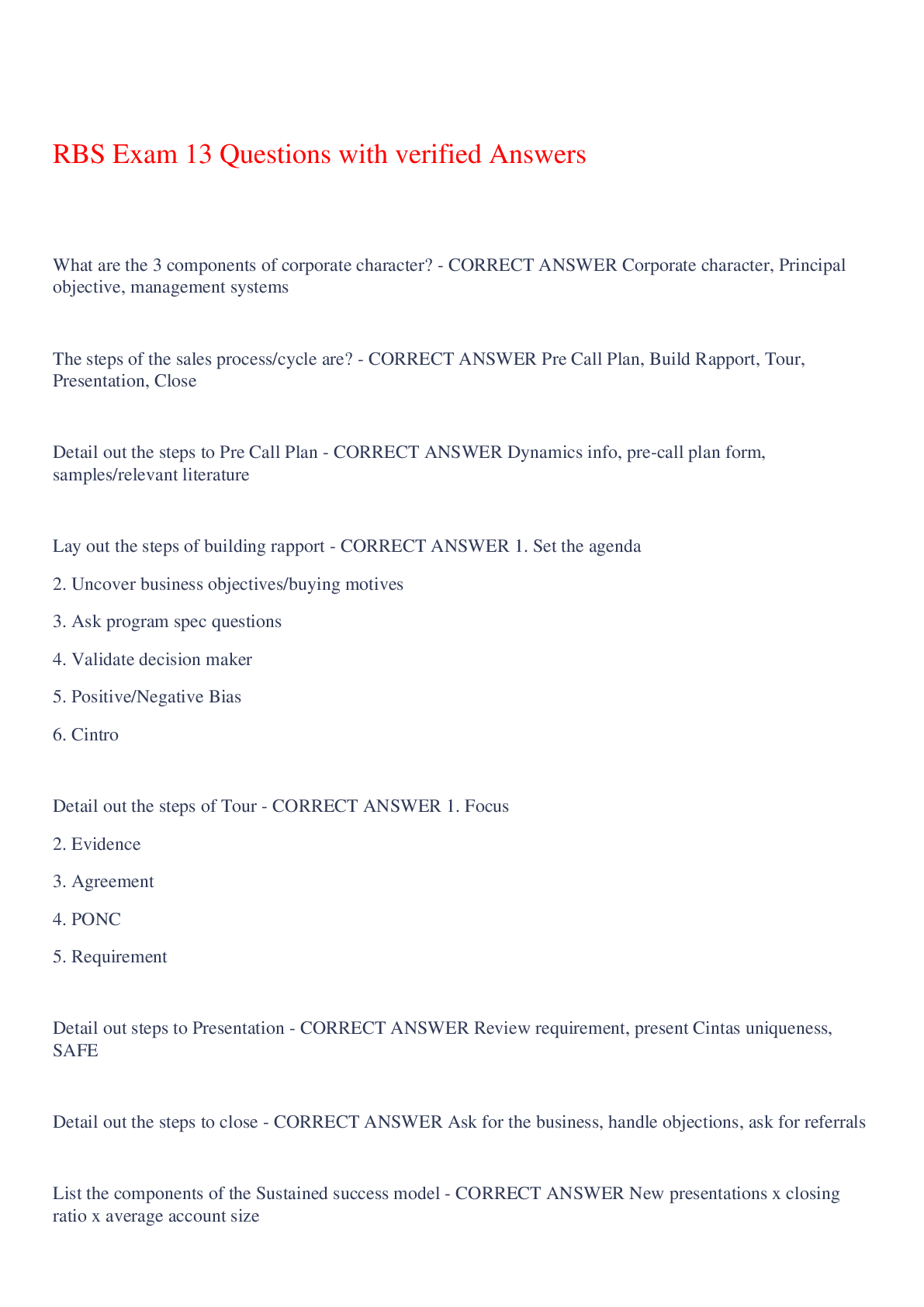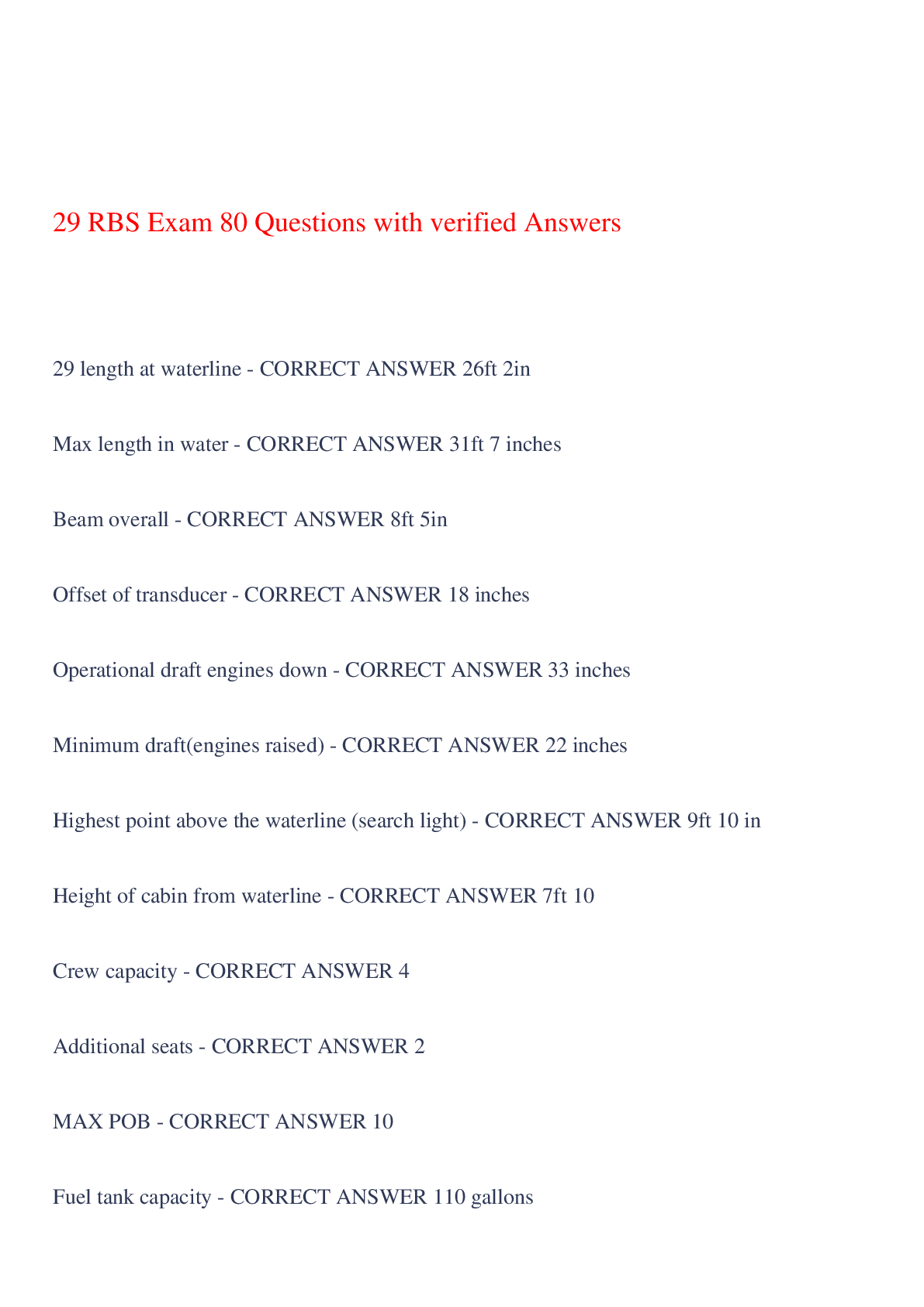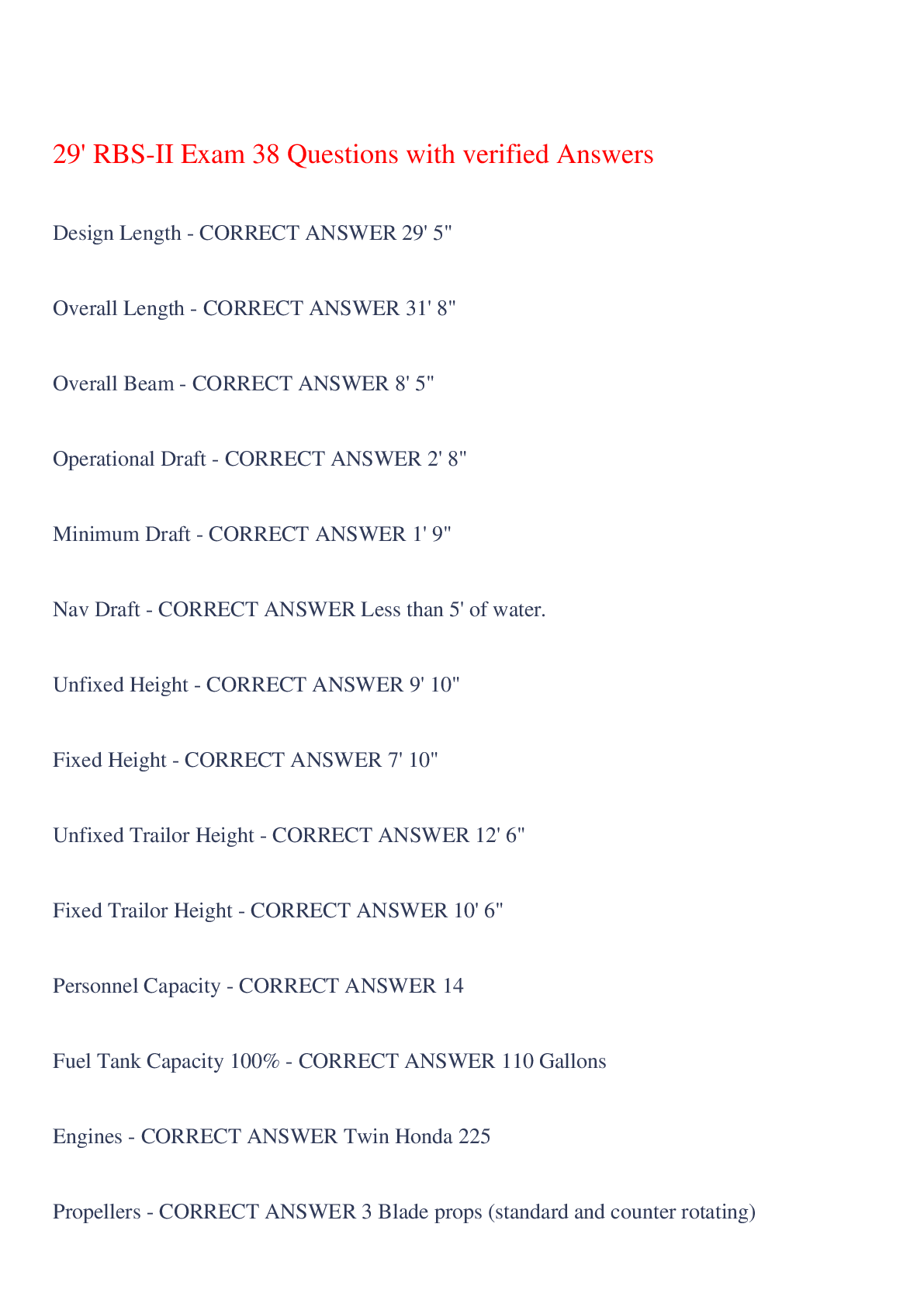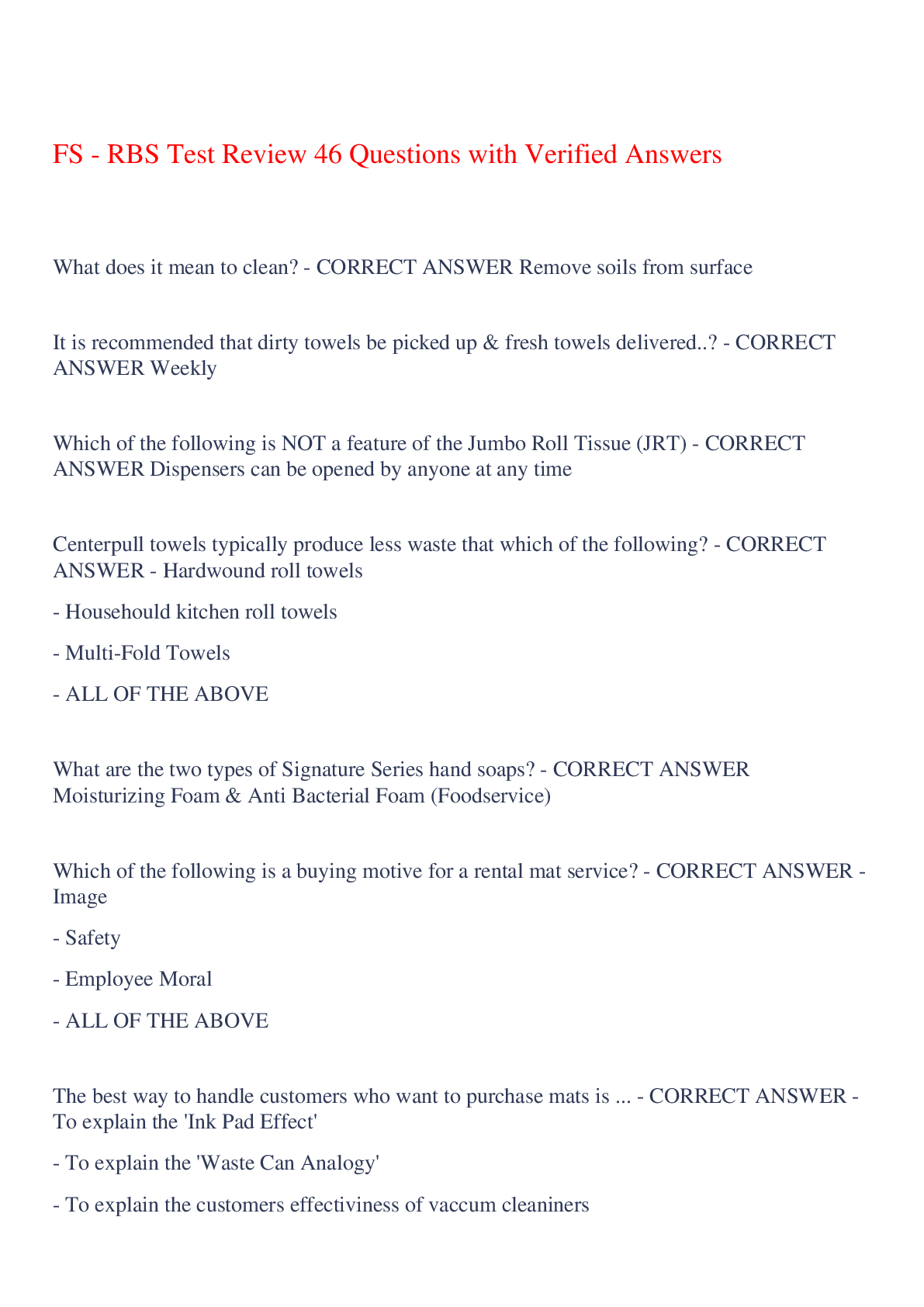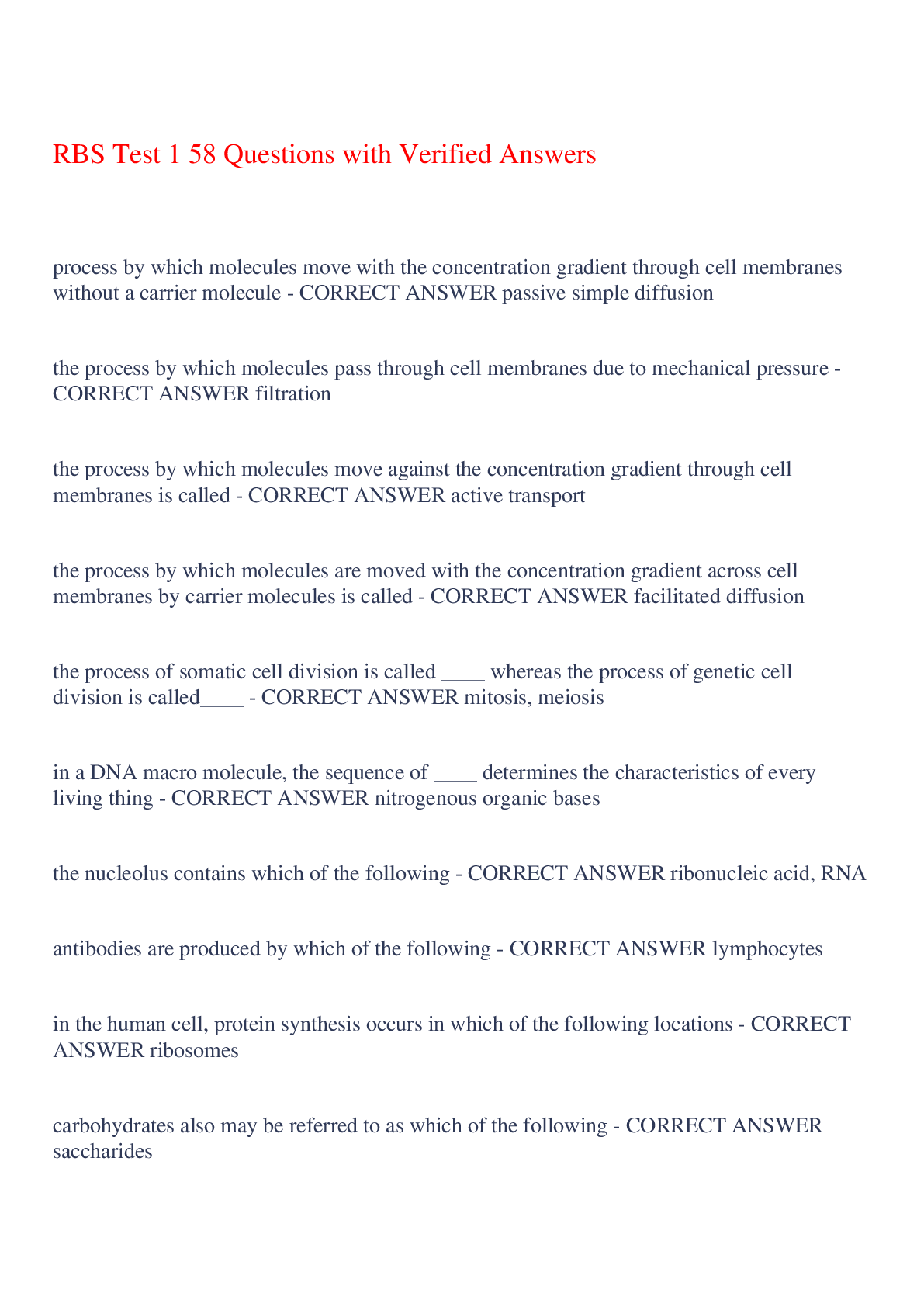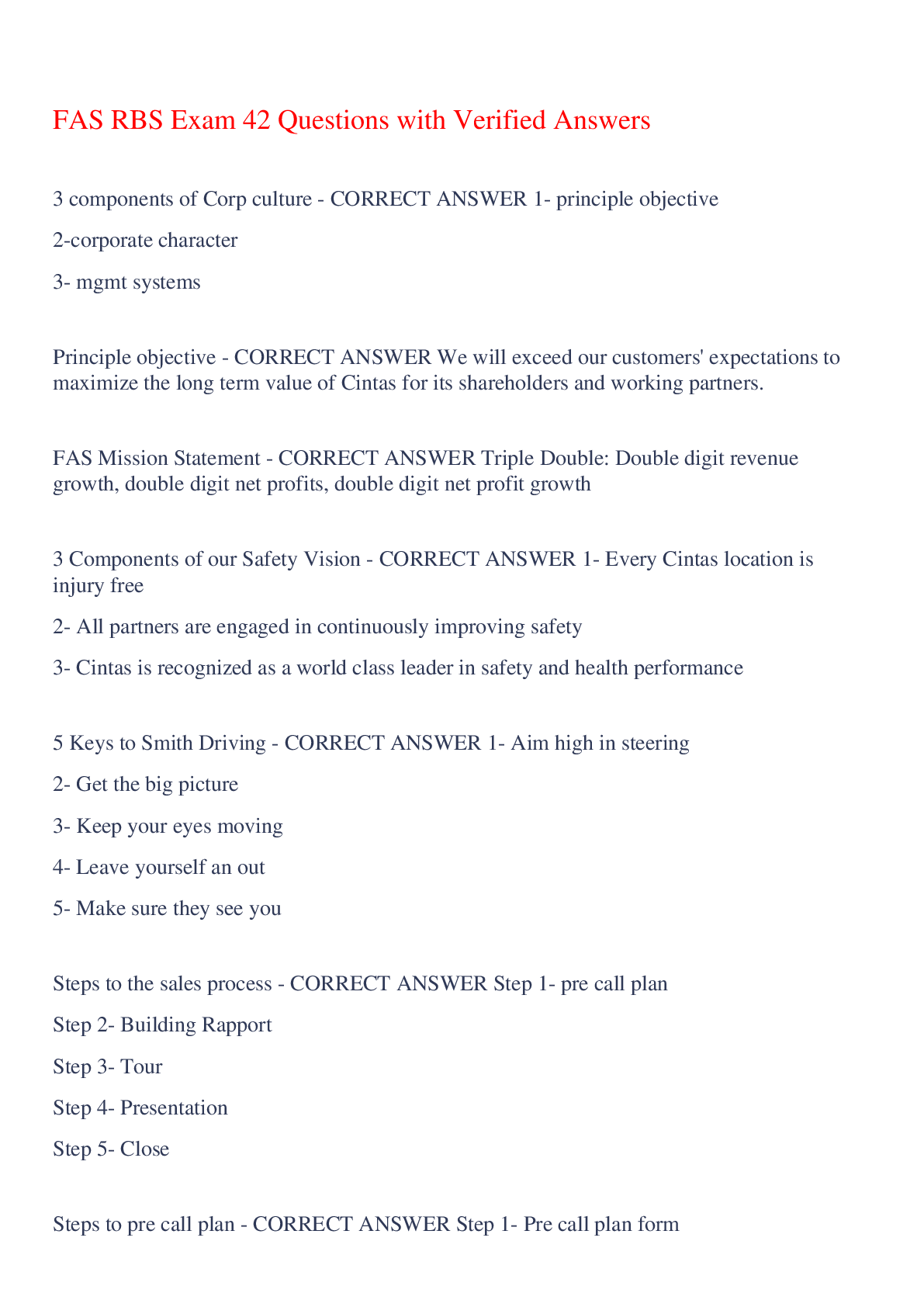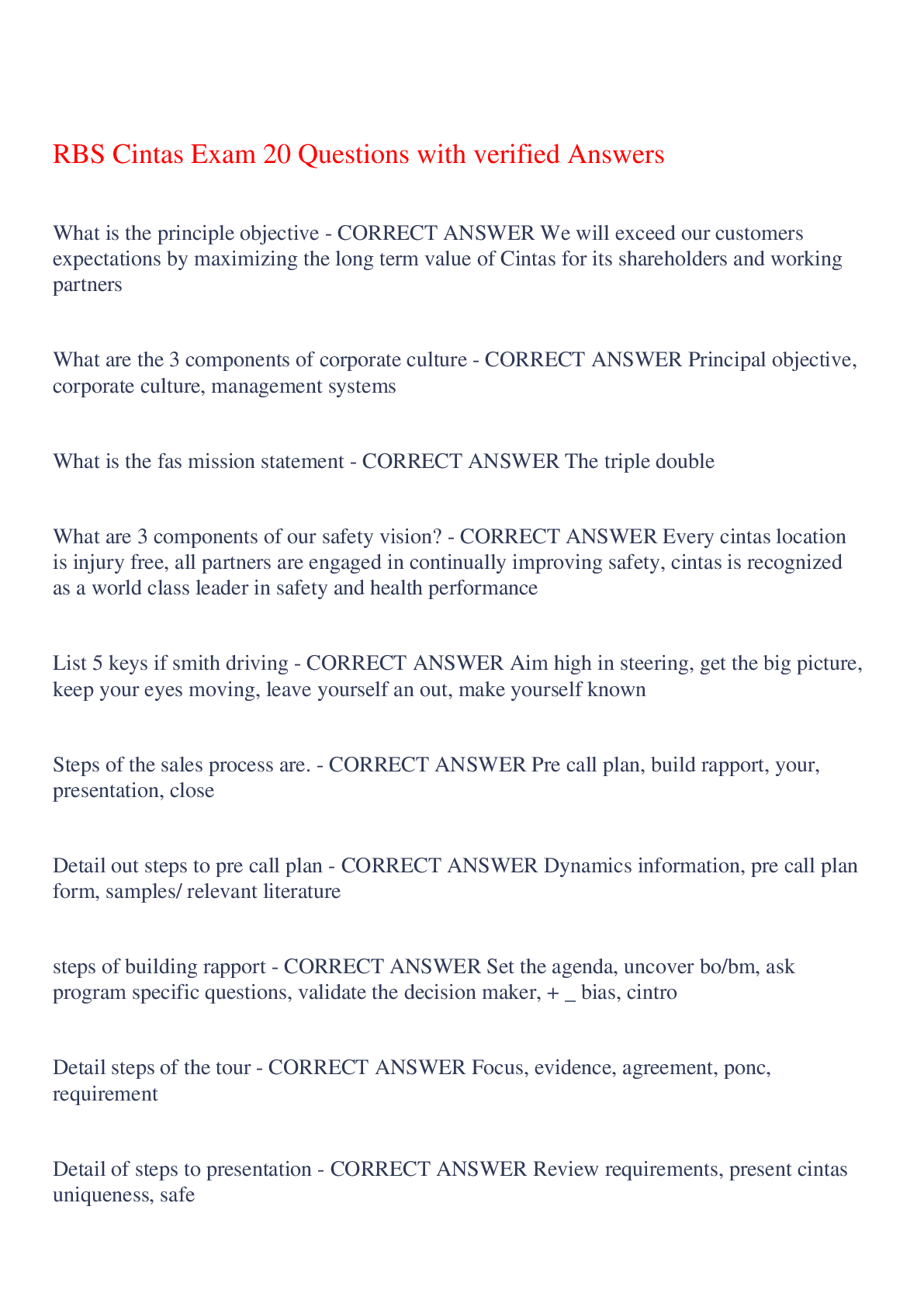NCLEX Practice Exam 1|40 Questions with Verified Answers,100% CORRECT
Document Content and Description Below
NCLEX Practice Exam 1|40 Questions with Verified Answers A nurse is providing care based on Maslow's hierarchy of basic human needs. For which nursing activities is this approach useful? a. Maki... ng accurate nursing diagnoses b. Establishing priorities of care c. Communicating concerns more concisely d. Integrating science into nursing care - CORRECT ANSWER b. Maslow's hierarchy of basic human needs is useful for establishing priorities of care. The nurse is prioritizing nursing care for a patient in a long-term care facility. Which examples of nursing interventions help meet physiologic needs? Select all that apply. a. Preventing falls in the facility b. Changing a patient's oxygen tank c. Providing materials for a patient who likes to draw d. Helping a patient eat his dinner e. Facilitating a visit from a spouse f. Referring a patient to a cancer support group. - CORRECT ANSWER b, d. Physiologic needs—oxygen, water, food, elimination, temperature, sexuality, physical activity, and rest—must be met at least minimally to maintain life. Providing food and oxygen are examples of interventions to meet these needs. Preventing falls helps meet safety and security needs, providing art supplies may help meet self-actualization needs, facilitating visits from loved ones helps meet self-esteem needs, and referring a patient to a support group helps meet love and belonging needs. The nurse caring for patients postoperatively uses careful hand hygiene and sterile techniques when handling patients. Which of Maslow's basic human needs is being met by this nurse? a. Physiologic b. Safety and security c. Self-esteem d. Love and belonging - CORRECT ANSWER b. By carrying out careful hand hygiene and using sterile technique, nurses provide safety from infection. An example of a physiologic need is clearing a patient's airway. Self-esteem needs may be met by allowing an older adult to talk about a past career. An example of helping meet a love and belonging need is contacting a hospitalized patient's family to arrange a visit. The nurse caring for patients in a long-term care facility knows that the highest level on Maslow's hierarchy of needs is self-actualization needs. Which statements accurately describe the achievement of self-actualization? Select all that apply. a. Humans are born with a fully developed sense of self-actualization. b. Self-actualization needs are met by depending on others for help. c. The self-actualization process continues throughout life. d. Loneliness and isolation occur when self-actualization needs are unmet. e. A person achieves self-actualization by focusing on problems outside self. f. Self-actualization needs may be met by creatively solving problems. - CORRECT ANSWER c, e, f. Self-actualization, or reaching one's full potential, is a process that continues throughout life. A person achieves self-actualization by focusing on problems outside oneself and using creativity as a guideline for solving problems and pursuing interests. Humans are not born with a fully developed sense of self-actualization, and self-actualization needs are not met specifically by depending on others for help. Loneliness and isolation are not always the result of unmet self-actualization needs. A nurse works with families in crisis at a community mental health care facility. What is the best broad definition of a family? a. A father, a mother, and children b. A group whose members are biologically related c. A unit that includes aunts, uncles, and cousins d. A group of people who live together and depend on each other for support - CORRECT ANSWER d. Although all the responses may be true, the best definition is a group of people who live together and depend on each other for physical, emotional, or financial support. A nurse performs an assessment of a family consisting of a single mother, a grandmother, and two children. Which interview questions directed to the single mother could the nurse use to assess the affective and coping family function? Select all that apply. a. Who is the person you depend on for emotional support? b. Who is the breadwinner in your family? c. Do you plan on having any more children? d. Who keeps your family together in times of stress? e. What family traditions do you pass on to your children? f. Do you live in an environment that you consider safe? - CORRECT ANSWER a, d. The five major areas of family function are physical, economic, reproductive, affective and coping, and socialization. Asking who provides emotional support in times of stress assesses the affective and coping function. Assessing the breadwinner focuses on the economic function. Inquiring about having more children assesses the reproductive function, asking about family traditions assesses the socialization function, and checking the environment assesses the physical function. The nurse caring for families in a free health care clinic identifies psychosocial risk factors for altered family health. Which example describes one of these risk factors? a. The family does not have dental care insurance or resources to pay for it. b. Both parents work and leave a 12-year old child to care for his younger brother. c. Both parents and their children are considerably overweight. d. The youngest member of the family has cerebral palsy and needs assistance from community services. - CORRECT ANSWER b. Inadequate childcare resources is a psychosocial risk factor. Not having access to dental care and obese family members are lifestyle risk factors. Having a family member with birth defects is a biologic risk factor. Shuba and Raul are a couple in their late seventies. According to Duvall, which developmental task is appropriate for this older adult family? a. Maintain a supportive home base b. Strengthen marital relationships c. Cope with loss of energy and privacy d. Adjust to retirement - CORRECT ANSWER d. The developmental tasks of the family with older adults are to adjust to retirement and possibly to adjust to the loss of a spouse and loss of independent living. Maintaining a supportive home base and strengthening marital relationships are tasks of the family with adolescents and young adults. Coping with loss of energy and privacy is a task of the family with children. A visiting nurse performs a community assessment in an area of the city in which the nurse will be working. What is one element of a healthy community? a. Meets all the needs of its inhabitants b. Has mixed residential and industrial areas c. Offers access to health care services d. Has modern housing and condominiums - CORRECT ANSWER c.A healthy community offers access to health care services to treat illness and to promote health. A healthy community does not usually meet all the needs of its residents, but should be able to help with health issues such as nutrition, education, recreation, safety, and zoning regulations to separate residential sections from industrial ones. The age of housing is irrelevant as long as residences are maintained properly according to code. A nurse is practicing community-based nursing in a mobile health clinic. What would be the central focus of this nurse's care? a. Individual and family health care needs b. Populations within the community c. Local health care facilities d. Families in crisis - CORRECT ANSWER a. In contrast to community health nursing, whichfocuses on populations within a community, community-based nursing is centered on individual and family health care needs. Community-based nurses may help families in crisis and work in health care facilities, but these are not the focus of community-based nursing A nurse is caring for a patient in the ICU who is being monitored for a possible cerebral aneurysm following a loss of consciousness in the emergency room. The nurse anticipates preparing the patient for ordered diagnostic tests. This nurse's knowledge of the diagnostic procedures for this condition reflects which aspect of nursing? a. The art of nursing b. The science of nursing c. The caring aspect of nursing d. The holistic approach to nursing - CORRECT ANSWER b. The science of nursing is the knowledge base for care that is provided. In contrast, the skilled application of that knowledge is the art of nursing. Providing holistic care to patients based on the science of nursing is considered the art of nursing. Which nurse who was influential in the development of nursing in North America is regarded as the founder of American nursing? a. Clara Barton b. Lillian Wald c. Lavinia Dock d. Florence Nightingale - CORRECT ANSWER d. Florence Nightingale elevated the status of nursing to a respected occupation, improved the quality of nursing care, and founded modern nursing education. Clara Barton established the Red Cross in the United States in 1882. Lillian Wald is the founder of public health nursing. Lavinia Dock was a nursing leader and women's rights activist instrumental in womens' right to vote. In early civilizations, the theory of animism attempted to explain the mysterious changes occurring in bodily functions. Which statement describes a component of the development of nursing that occurred in this era? a. Women who committed crimes were recruited into nursing the sick in lieu of serving jail sentences. b. Nurses identified the personal needs of the patient and their role in meeting those needs. c. Women called deaconesses made the first visits to the sick and male religious orders cared for the sick and buried the dead. d. The nurse was the mother who cared for her family during sickness by using herbal remedies. - CORRECT ANSWER d. The theory of animism was based on the belief that everything in nature was alive with invisible forces and endowed with power. In this era, the nurse usually was the mother who cared for her family during sickness by providing physical care and herbal remedies. At the beginning of the 16th century the shortage of nurses led to the recruitment of women who had committed crimes to provide nursing care instead of going to jail. In the early Christian period, women called deaconesses made the first organized visits to sick people, and members of male religious orders gave nursing care and buried the dead. The influences of Florence Nightingale were apparent from the middle of the 19th century to the 20th century; one of her accomplishments was identifying the personal needs of the patient and the nurse's role in meeting those needs. World War II had a tremendous effect on the nursing profession. Which development occurred during this period? a. The role of the nurse was broadened. b. There was a decreased emphasis on education. c. Nursing was practiced mainly in hospital settings. d. There was an overabundance of nurses. - CORRECT ANSWER a. During World War II, large numbers of women worked outside the home. They became more independent and assertive, which led to an increased emphasis on education. The war itself created a need for more nurses and resulted in a knowledge explosion in medicine and technology. This trend broadened the role of nurses to include practicing in a wide variety of health care settings. Which phrase describes a purpose of the ANA's Nursing's Social Policy Statement? Select all that apply. a. To describe the nurse as a dependent caregiver b. To provide standards for nursing educational programs c. To define the scope of nursing practice d. To establish a knowledge base for nursing practice e. To describe nursing's social responsibility f. To regulate nursing research - CORRECT ANSWER c, d, e. The ANA Social Policy Statement (2010) describes the social context of nursing, a definition of nursing, the knowledge base for nursing practice, the scope of nursing practice, standards of professional nursing practice, and the regulation of professional nursing. One of the four broad aims of nursing practice is to restore health. Which examples of nursing interventions reflect this goal? Select all that apply. a. A nurse counsels adolescents in a drug rehabilitation program. b. A nurse performs range-of-motion exercises for a patient on bedrest. c. A nurse shows a diabetic patient how to inject insulin. d. A nurse recommends a yoga class for a busy executive. e. A nurse provides hospice care for a patient with end-stage cancer. f. A nurse teaches a nutrition class at a local high school. - CORRECT ANSWER a, b, c. Activities to restore health focus on the individual with an illness and range from early detection of a disease to rehabilitation and teaching during recovery. These activities include drug counseling, teaching patients how to administer their medications, and performing range-of-motion exercises for bedridden patients. Recommending a yoga class for stress reduction is a goal of preventing illness, and teaching a nutrition class is a goal of promoting health. A hospice care nurse helps to facilitate coping with disability and death. Nursing is recognized increasingly as a profession based on which defining criteria? Select all that apply. a. Well defined body of general knowledge b. Interventions dependent upon the medical practice c. Recognized authority by a professional group d. Regulation by the medical industry e. Code of ethics f. Ongoing research - CORRECT ANSWER c, e, f. Nursing is recognized increasingly as a profession based on the following defining criteria: well-defined body of specific and unique knowledge, strong service orientation, recognized authority by a professional group, code of ethics, professional organization that sets standards, ongoing research, and autonomy and self-regulation. A nurse is practicing as a nurse-midwife in a busy OB-GYN office. Which degree in nursing is necessary to practice at this level? a. LPN b. ADN c. BSN d. MSN - CORRECT ANSWER d. A master's degree (MSN) prepares advanced practice nurses. Many master's graduates gain national certification in their specialty area, for example, as family nurse practitioners (FNPs) or nurse midwives. Nurse practice acts are established in each state of the United States to regulate nursing practice. What is a commonelement of every state practice act? a. Defining the legal scope of nursing practice b. Providing continuing education programs c. Determining the content covered in the NCLEXexamination d. Creating institutional policies for health care practices - CORRECT ANSWER a. Nurse practice acts are established in each state to regulate the practice of nursing by defining the legal scope of nursing practice, creating a state board of nursing to make and enforce rules and regulations, define important terms and activities in nursing, and establish criteria for the education and licensure of nurses. The acts do not determine the content covered on the NCLEX, but they do have the legal authority to allow graduates of approved schools of nursing to take the licensing examination. The acts also may determine educational requirements for licensure, but do not provide the education. Institutional policies are created by the institutions themselves. The National Advisory Council on Nurse Education and Practice identifies critical challenges to nursing practice in the 21st century. What is a current health care trend contributing to these challenges? a. Decreased numbers of hospitalized patients b. Older and more acutely ill patients c. Decreasing health care costs due to managed care d. Slowed advances in medical knowledge and technology - CORRECT ANSWER b. The National Advisory Council on Nurse Education and Practice identifies the following critical challenges to nursing practice in the 21st century: A growing population of hospitalized patients who are older and more acutely ill, increasing health care costs, and the need to stay current with rapid advances in medical knowledge and technology. . A nurse assesses patients in a physician's office who are experiencing different levels of health and illness. Which statements best define the concepts of health and illness? Select all that apply. a. Health and illness are the same for all people. b. Health and illness are individually defined by each person. c. People with acute illnesses are actually healthy. d. People with chronic illnesses have poor health beliefs. e. Health is more than the absence of illness. f. Illness is the response of a person to a disease. - CORRECT ANSWER b, e, f. Each person defines health and illness individually, based on a number of factors. Health is more than just the absence of illness; it is an active process in which a person moves toward one's maximum potential. An illness is the response of the person to a disease. The student nurse learns that illnesses are classified as either acute or chronic. Which are examples of chronic illnesses? Select all that apply. a. Diabetes mellitus b. Bronchial pneumonia c. Rheumatoid arthritis d. Cystic fibrosis e. Fractured hip f. Otitis media - CORRECT ANSWER a, c, d. Diabetes, arthritis, and cystic fibrosis are chronic diseases because they are permanent changes caused by irreversible alterations in normal anatomy and physiology, and they require patient education along with a long period of care or support. Pneumonia, fractures, and otitis media are acute illnesses because they have a rapid onset of symptoms that last a relatively short time. Despite a national focus on health promotion, nurses working with patients in inner-city clinics continue to see disparities in health care for vulnerable populations. Which patients would be considered vulnerable populations? Select all that apply. a. A White male diagnosed with HIV b. An African American teenager who is 6 months pregnant c. A Hispanic male who has type II diabetes d. A low-income family living in rural America e. A middle-class teacher living in a large city f. A White baby who was born with cerebral palsy - CORRECT ANSWER b, c, d, f. National trends in the prevention of health disparities are focused on vulnerable populations, such as racial and ethnic minorities, those living in poverty, women, children, older adults, rural and inner-city residents, and people with disabilities and special health care needs. A nurse has volunteered to give influenza immunizations at a local clinic. What level of care is the nurse demonstrating? a. Tertiary b. Secondary c. Primary d. Promotive - CORRECT ANSWER c. Giving influenza injections is an example of primary health promotion and illness prevention. A nurse's neighbor tells the nurse, "I have a high temperature, feel awful, and I am not going to work." What stage of illness behavior is the neighbor exhibiting? a. Experiencing symptoms b. Assuming the sick role c. Assuming a dependent role d. Achieving recovery and rehabilitation - CORRECT ANSWER b. When people assume the sick role, they define themselves as ill, seek validation of this experience from others, and give up normal activities. In stage 1: experiencing symptoms, the first indication of an illness usually is recognizing one or more symptoms that are incompatible with one's personal definition of health. The stage of assuming a dependent role is characterized by the patient's decision to accept the diagnosis and follow the prescribed treatment plan. In the achieving recovery and rehabilitation role, the person gives up the dependent role and resumes normal activities and responsibilities. Which clinic patient is most likely to have annual breast examinations and mammograms based on the physical human dimension? a. Jane, whose her best friend had a benign breast lump removed b. Sarah, who lives in a low-income neighborhood c. Tricia, who has a family history of breast cancer d. Nancy, whose family encourages regular physical examinations - CORRECT ANSWER c. The physical dimension includes genetic inheritance, age, developmental level, race, and gender. These components strongly influence the person's health status and health practices. A family history of breast cancer is a major risk factor. Health promotion activities may occur on a primary, secondary, or tertiary level. Which activities are considered tertiary health promotion? Select all that apply. a. A nurse runs an immunization clinic in the inner city. b. A nurse teaches a patient with an amputation how to care for the residual limb. c. A nurse provides range-of-motion exercises for a paralyzed patient. d. A nurse teaches parents of toddlers how to childproof their homes. e. A school nurse provides screening for scoliosis for the students. f. A nurse teaches new parents how to choose and use an infant car seat. - CORRECT ANSWER b, c. Tertiary health promotion and disease prevention begins after an illness is diagnosed and treated to reduce disability and to help rehabilitate patients to a maximum level of functioning. These activities include providing ROM exercises and patient teaching for residual limb care. Providing immunizations and teaching parents how to childproof their homes and use an appropriate car seat are primary health promotion activities. Providing screenings is a secondary health promotion activity. The agent-host-environment model of health and illness is based on what concept? a. Risk factors b. Demographic variables c. Behaviors to promote health d. Stages of illness - CORRECT ANSWER a. The interaction of the agent, host, and environment creates risk factors that increase the probability of disease. When providing health promotion classes, a nurse uses concepts from models of health. What do both the health-illness continuum and the high-level wellness models demonstrate? a. Illness as a fixed point in time b. The importance of family c. Wellness as a passive state d. Health as a constantly changing state - CORRECT ANSWER d. Both these models view health as a dynamic (constantly changing state). A nurse follows accepted guidelines for a healthy lifestyle. How can this promote health in others? a. By being a role model for healthy behaviors b. By not requiring sick days from work c. By never exposing others to any type of illness d. By spending less money on food - CORRECT ANSWER a. Good personal health enables the nurse to serve as a role model for patients and families. Nursing students are reviewing information about health care delivery systems in preparation for a quiz the next day. Which statements describe current U.S. health care delivery practices? Select all that apply. a. Access to care depends only on the ability to pay, not the availability of services. b. The Patient Protection and Affordable Care Act provides private health care insurance to the underserved populations. c. Every health insurance plan in the Marketplace offers comprehensive coverage, from doctors to medications to hospital visits. d. The uninsured pay for more than one-third of their care out of pocket and are usually charged lower amounts for their care than the insured pay. e. Fifty years ago, half of the doctors in America practiced primary care, but today fewer than one in three do. f. Quality of care can be defined as the right care for the right person at the right time. - CORRECT ANSWER c, e, f. The Marketplace is designed to help people more easily find health insurance that fits their budget. Every health insurance plan in the Marketplace offers comprehensive coverage, from doctors to medications to hospital visits. Fifty years ago, half of the doctors in America practiced primary care, but today fewer than one in three do. Quality is the right care for the right person at the right time. Access to care depends on both the ability to pay and the availability of services. The Patient Protection and Affordable Care Act provides Medicaid or subsidized coverage to qualifying people with incomes up to 400% of poverty. The uninsured pay for more than one-third of their care out of pocket and are often charged higher amounts for their care than the insured pay. A nurse is providing secondary health care to patients in a health care facility. Which patients are receiving this level of care? Select all that apply. a. A patient enters a community clinic with signs of strep throat. b. A patient is admitted to the hospital following a myocardial infarction. c. A mother brings her son to the emergency department following a seizure. d. A patient with osteogenesis imperfecta is being treated in a medical center. e. A mother brings her son to a specialist to correct a congenital heart defect. f. A woman has a hernia repair in an ambulatory care center. - CORRECT ANSWER b, c, f. Secondary health care treats problems that require specialized clinical expertise, such as an MI, a seizure, and a hernia repair. Treating strep throat is primary health care.Tertiary health care involves management of rare and complex disorders, such as osteogenesis imperfecta and congenital heart malformations. A nurse working in a physician's office prepares insurance forms in which the provider is given a fixed amount per enrollee of the health plan. What is the term for this type of reimbursement? a. Capitation b. Prospective payment system c. Bundled payment d. Rate setting - CORRECT ANSWER a. Capitation plans give providers a fixed amount per enrollee in the health plan in an effort to build a payment plan that consists of the best standards of care at the lowest cost. The prospective payment system groups inpatient hospital services for Medicare patients into DRGs. With bundled payments, providers receive a fixed sum of money to provide a range of services. Rate setting means that the government could set targets or caps for spending on health care services. A nursing instructor is teaching students about the utilization of health care services and how the U.S. health care dollar is spent. Place the following care areas in order from the highest percentage of health care money spent to the lowest. a. Physician/clinical services b. Home health care c. Long-term care facility services d. Retail prescription drugs e. Government administration f. Hospital care - CORRECT ANSWER f, a, d, c, b, e. The national health expenditures in 2010 were hospital care 31%, physician/clinical services 20%, retail prescription drugs 10%, long-term care facility services 5%, home health care 3%, and government administration 1%. A nurse researcher keeps current on the trends to watch in healthcare delivery. What trends are likely included? Select all that apply. a. Globalization of economy and society b. Slowdown in technology development c. Decreasing diversity d. Increasing complexity of patient care e. Changing demographics f. Shortages of key health care professionals and educators - CORRECT ANSWER a, d, e, f. Trends to watch in health care delivery include: globalization of the economy and society, increasing complexity of patient care, changing demographics, shortages of key health care professionals and educators, technology explosion, and increasing diversity. A nurse is caring for patients in a primary care center. What is the most likely role of this nurse based on the setting? a. Assisting with major surgery b. Performing a health assessment c. Maintaining patients' function and independence d. Keeping student immunization records up to date - CORRECT ANSWER b. Performing patient assessments is a common role of the nurse in a primary care center. Assisting with major surgery is a role of the nurse in the hospital setting. Maintaining patients' function and independence is a role of the nurse in an extended-care facility, and keeping student immunization records up to date is a role of the school nurse. A caregiver asks a nurse to explain respite care. How would the nurse respond? a. "A service that allows time away for caregivers" b. "A special service for the terminally ill and their family" c. "Direct care provided to individuals in a long-term care facility" d. "Living units for people without regular shelter" - CORRECT ANSWER a. Respite care is provided to enable a primary caregiver time away from the day-to-day responsibilities of homebound patients. A nurse caring for patients in a primary care setting submits paperwork for reimbursement from managed care plans for services performed. Which purpose best describes managed care as a framework for health care? a. A design to control the cost of care while maintaining the quality of care b. Care coordination to maximize positive outcomes to contain costs c. The delivery of services from initial contact through ongoing care d. Based on a philosophy of ensuring death in comfort and dignity - CORRECT ANSWER a. Managed care is a way of providing care designed to control costs while maintaining the quality of care. A nurse cares for dying patients by providing physical, psychological, social, and spiritual care for the patients, their families, and other loved ones. This service is known as: a. Respite care b. Palliative care c. Hospice care d. Extended care - CORRECT ANSWER c. The hospice nurse combines the skills of the home care nurse with the ability to provide daily emotional support to dying patients and their families. Respite care is a type of care provided for caregivers of homebound ill, disabled, or older patients. Palliative care, which can be used inconjunction with medical treatment and in all types of health care settings, is focused on the relief of physical, mental, and spiritual distress. Extended-care facilities include transitional subacute care, assisted-living facilities, intermediate and long-term care, homes for medically fragile children, retirement centers, and residential institutions for mentally and developmentally or physically disabled patients of all ages. A nurse is evaluating a patient diagnosed with renaldisease for treatment in a Hospital at Home program. Whichstatement accurately describes a step in this program? a. The patient is evaluated upon hospital admission and is given daily nursing care in the home after discharge for as long as necessary. b. Any urgent or emergent situation requires an ambulance trip from the home to the hospital. c. Patients are transported to physicians' offices from the home for weekly evaluations. d. The clinicians use care pathways, clinical outcome evaluations, and specific discharge criteria. - CORRECT ANSWER d. In the Hospital at Home program, the clinicians use care pathways including illness-specific care maps, clinical outcome evaluations, and specific discharge criteria. A patient requiring admission for one of the target illnesses is identified in the emergency department or ambulatory site. Staff assess whether the patient is a good candidate for the program using validated criteria. If the patient is eligible and consents to participate, the Hospital at Home physician evaluates the patient, who is then transported home, usually by ambulance. Nurses are available 24 hours a day/7 days a week for any urgent or emergent situations. The patient is evaluated daily in the home by the Hospital at Home physician, who completes an assessment and continues to implement appropriate diagnostic and therapeutic measures. [Show More]
Last updated: 7 months ago
Preview 1 out of 16 pages
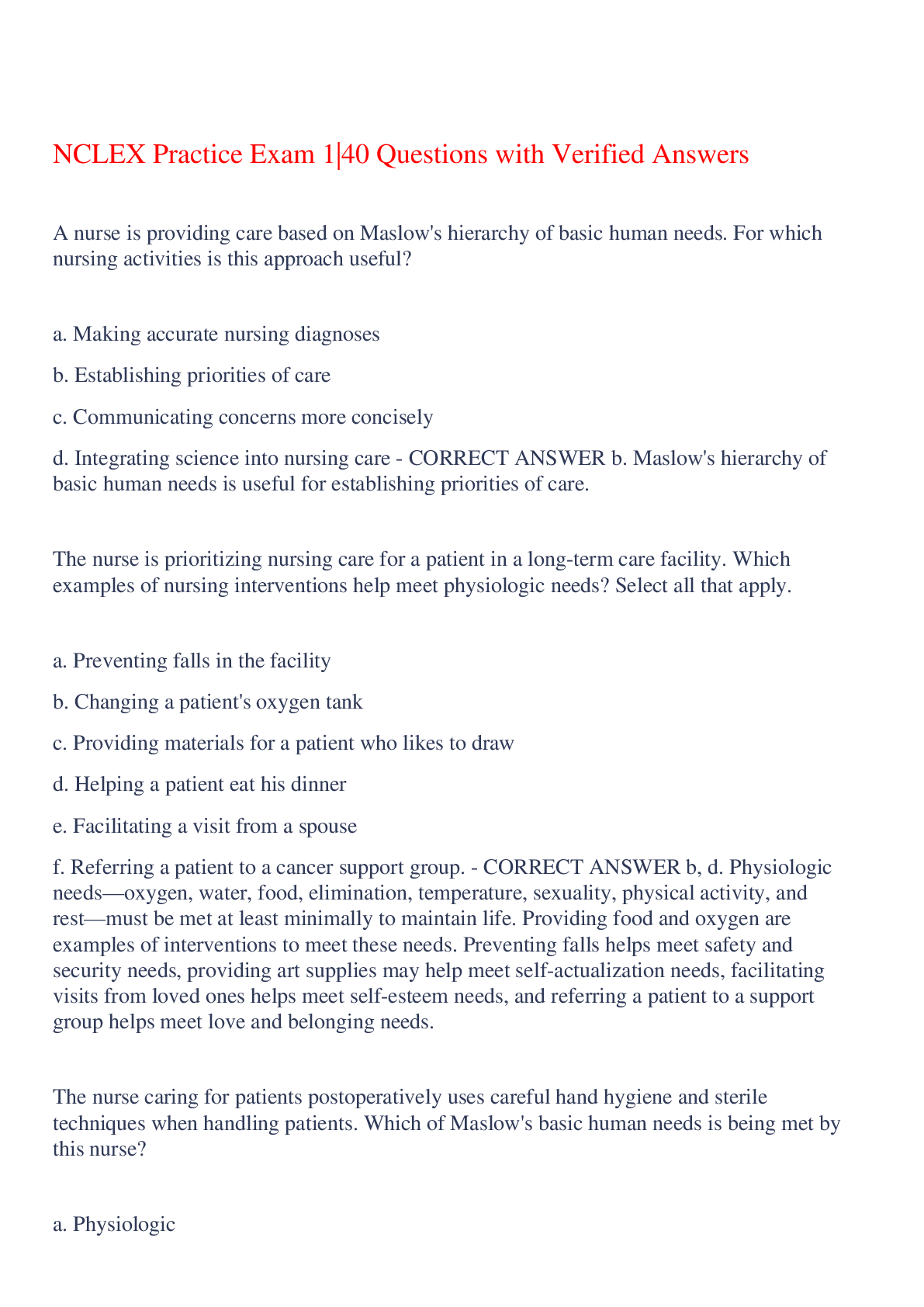
Buy this document to get the full access instantly
Instant Download Access after purchase
Add to cartInstant download
We Accept:

Reviews( 0 )
$8.00
Document information
Connected school, study & course
About the document
Uploaded On
Nov 12, 2023
Number of pages
16
Written in
Additional information
This document has been written for:
Uploaded
Nov 12, 2023
Downloads
0
Views
44















